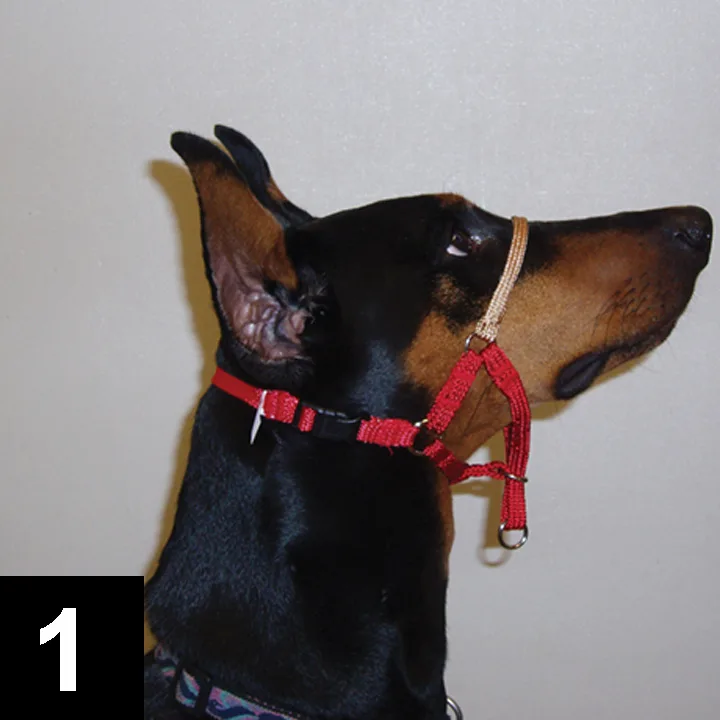Territorial Aggression in Dogs
How can I help stop my patient from showing territorial aggression when visitors come to my client’s home?
Excessive territorial aggression is often seen in poorly socialized dogs and appears to carry a significant degree of fear of the visitor.
Territorial behavior is normal in dogs. Dog owners accept (and may even expect) dogs to bark an alert when someone approaches the home. The behavior becomes problematic when it is excessive, is out of the owner’s control, and/or poses a risk to the public under ordinary circumstances.
For domestic dogs, territory generally encompasses the owner’s house, yard, and possibly the space in and around a vehicle or crate. Territorial behavior tends to be most intense directly along boundary lines, and dogs may protect small territories more intensely than large ones.1 Unlike fear aggression, which often manifests at an early age, territorial behavior is not expected until 6 months of age or older2 (see Important History Questions).
Related Article: The Mailman Syndrome
Excessive territorial aggression is often seen in poorly socialized dogs and appears to carry a significant degree of fear of the visitor. Excessive territorial aggression manifests as an aggressive response that is disproportionately elevated with regard to the degree of actual threat.
Health Status & History
Dogs exhibiting territorial aggression should be evaluated for medical conditions that could affect behavioral expression or impact the dog’s ability to undergo training. Orthopedic disease may limit certain therapeutic interventions. For example, cervical or spinal disease may necessitate adaptation to training and equipment (eg, harness vs collar) and may induce chronic pain.
Related Article: Dogs That Chase
Owners often grab dogs by the collar when a visitor is at the front door; if this causes pain, the dog may associate that pain with a visitor.
Certain medications also may affect the dog’s arousal and/or anxiety level.
Certain medications may also affect the dog’s arousal and/or anxiety level. Corticosteroids can cause some dogs to become aggressive or irritable. Phenylpropanolamine can also cause aggression.
Differential Diagnosis
Medical differentials include conditions that may increase anxiety (eg, hypothyroidism, hyperadrenocorticism, sensory deficits [loss of hearing, vision]), medications (eg, glucocorticoids, phenylpropanolamine, theophylline), pain-related disorders, and various neurologic disorders, especially those affecting perception or the processing of perceptual stimuli.
Behavioral differentials include separation distress, noise or storm phobia, reaction to animals (eg, prey species outside the home), and purposeful or inadvertent reinforcement of territorial reactions.
Prognosis
Prognosis is highly variable (eg, good to poor). Outcome depends largely on owner compliance and the dog’s behavioral profile.
Treatment at a Glance
Meet the dog’s behavioral needs.
The behavior may be more intense if the dog is chronically frustrated by lack of exercise. Aerobic exercise can help the dog expend energy and releases endorphins that may promote calmer behavior.3
Long-duration enrichment (eg, food scattering, frozen stuffed Kong toys, food-dispensing balls, nose work games) can help replace the time the dog spends guarding with a more appropriate behavioral outlet.
Appropriate social contact with family members is essential. Because dogs are a social species, isolation may contribute to various behavior disturbances and owner complaints. Structured social contact could include training, walking, playing organized games, grooming, and the like.
Institute management steps.
Arrange the dog’s living space and schedule to minimize or eliminate its ability to rehearse, and be reinforced for, inappropriate behavior.
Prevent the dog from barking at windows or doors. This can be done by blocking the dog from these areas with gates or location repellents or by crating or confining the dog, especially in the owner’s absence. Owners can cover windows with opaque window film.
In multidog households, separating the dogs may reduce social facilitation of territorial reactions.
Avoid leaving the dog unsupervised while outdoors, where it may run the fence line and bark and charge at people or animals as they pass by or are in neighboring yards. The dog can be taken into the yard while on a leash.
Use appropriate equipment, such as head halters (Figure 1) and muzzles, to ensure safety.

Institute behavior modification interventions.
Teach basic cues so the owner has verbal control over the dog and can ask for alternative behavior.
Have the owner reinforce calm behavior throughout daily interactions.
Begin exercises to teach conditioned relaxation on stationing spots in the sitting area and a short distance from the front door so the dog learns to sit or lie calmly in these areas even while distracted (Figure 2. The goal is to have the dog remain calm and quiet when visitors arrive).
Begin desensitization and counterconditioning to visitors with the dog on a leash. Introduce the dog in structured exposure sessions of gradually increasing duration.
The dog should be asked to lie quietly at its station and the behavior should be reinforced by offering high-value treats.
Over the course of sessions, gradually expose the dog to various visitor actions (eg, standing up, sitting down, speaking, looking at the dog, exiting and entering the room).
Evaluate the behavior for pharmacologic intervention.
Medication is most useful for impulse-control disorders, high physiologic arousal, generalized anxiety, and/or marked fearfulness.
Drugs can be administered daily (eg, fluoxetine, paroxetine, clomipramine, sertraline) or as needed (eg, trazodone, clonidine, gabapentin, benzodiazepines).
Giving test doses before starting a regimen is important because any drug, particularly benzodiazepines, can disinhibit or increase aggression.
LORE I. HAUG, DVM, MS, DACVB, practices in Houston, Texas, and lectures on general and behavioral medicine. She teaches animal behavior electives to professional students. Endorsed by National Association of Dog Obedience Instructors (NADOI), Dr. Haug is a certified professional dog trainer. She has authored numerous articles and is a member of the AVMA, ACVB, AVSAB, IAABC, and APDT. Dr. Haug earned her MS in veterinary medicine and her DVM at Texas A&M University, where she lectured for the Department of Small Animal Medicine and Surgery.